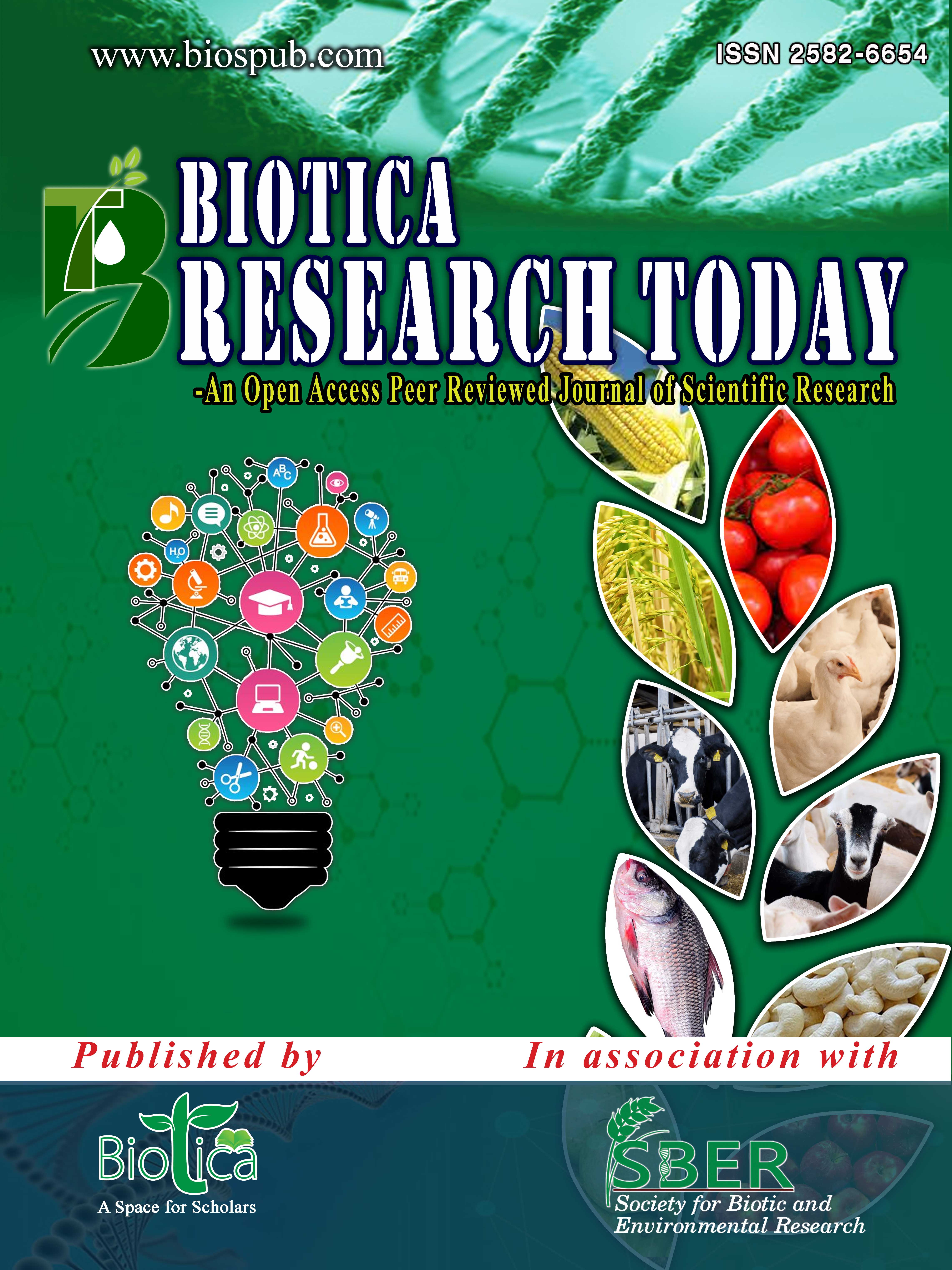Synergic Effects of Salinity and Rhizoctonia solani (Kuhn) Infection on Growth and Yield Attributes of Rice (Oryza sativa L.)
DOI:
https://doi.org/10.54083/PHA/2.1.2024/18-25Keywords:
Growth, Rice, Salinity, Sheath Blight, YieldAbstract
Salinity stress and Rhizoctonia solani pose significant threats to global rice production; however, their interactive effects on rice plants remain underexplored. This study aimed to determine the combined effects of different salt (NaCl) levels and R. solani (Kuhn) infection on selected growth and yield attributes of O. sativa. Faro44, Faro52 and Jamila rice varieties were subjected to varying NaCl concentrations and R. solani infection under screen house conditions, utilizing a Completely Randomized Block Design (CRBD) and Two-Way ANOVA was employed for data analysis. The results revealed that higher NaCl concentrations and R. solani infection retarded plant height, with the number of tillers and leaves being significantly affected. The lowest mean values occurred at a salinity level of 8 dS m-1; whereas highest values occurred at 4 dS m-1 and 6 dS m-1. The 100 seed weight varied depending on the NaCl concentration, with the lowest seed weight observed at 8 dS m-1 and 6 dS m-1 in Faro44 and the highest seed weight observed at 4 dS m-1. The grain length was found to be at its minimum when exposed to 8 dS m-1, while grain diameter exhibited its smallest size at 8 dS m-1 of salt levels. Variations in NaCl concentrations significantly influenced the number of panicles and length of panicles (NP and LP), and number of grains panicle-1. The lowest values were recorded at 8 dS m-1, whereas the highest values were observed at 0 dS m-1 and 2 dS m-1. The study found that, in rice plants infected by R. solani, growth and yield are further diminished under saline conditions, emphasizing the complex interaction between abiotic and biotic stressors in rice.
Downloads
References
Abu-Ria, M., Shukry, W., Abo-Hamed, S., Albaqami, M., Almuqadam, L., Ibraheem, F., 2023. Humic acid modulates ionic homeostasis, osmolytes content and antioxidant defense to improve salt tolerance in rice. Plants 12(9), 1834. DOI: https://doi.org/10.3390/plants12091834.
Al-hashimi, A.M., 2023. A review: Growing rice in the controlled environments. Biosciences Biotechnology Research Asia 20(1), 13-28. DOI: https://doi.org/10.13005/bbra/3064.
Anwar, A., Zhang, S., He, L., Gao, J., 2022. Understanding the physiological and molecular mechanism of salinity stress tolerance in plants. Notulae Botanicae Horti Agrobotanici Cluj-Napoca 50(4), 12959-12959. DOI: https://doi.org/10.15835/nbha50312959.
Bidalia, A., Vikram, K., Yamal, G., Rao, K.S., 2019. Effect of salinity on soil nutrients and plant health. In: Salt Stress, Microbes and Plant Interactions: Causes and Solution. Volume 1. (Ed.) Akhtar, M. Springer, Singapore. pp. 273-297. DOI: https://doi.org/10.1007/978-981-13-8801-9_13.
Chakrobortty, J., Akter, Y., Hoque, M.A., Hashem, M.A., 2022. Comparative studies on tolerance of two rice genotypes differing in their salinity tolerance. Asian Journal of Medical and Biological Research 8(4), 230-239. DOI: https://doi.org/10.3329/ajmbr.v8i4.62819.
Chalbi, A., Sghaier-Hammami, B., Baazaoui, N., Hammami, S.B.M., Ben-Jouira, H., García-Caparrós, P., Djébali, N., Regaya, I., Debez, A., Jorrín-Novo, J.V., Abdelly, C., 2021. Comparative study of the effect of salt stress, Alternaria alternata attack or combined stress on the Cakile maritima growth and physiological performance. Notulae Botanicae Horti Agrobotanici Cluj-Napoca 49(3), 12446-12446. DOI: https://doi.org/10.15835/nbha49312446.
Chen, D., Nahar, K., 2023. First report of Fusarium commune causing root rot of field peas in Canada. Plant Disease 107(7), 2259. DOI: https://doi.org/10.1094/PDIS-11-22-2657-PDN.
Effendi, A., Yoseva, S., Suningsih, S., 2023. Increasing the growth and yield of lowland rice (Oryza sativa L.) with optimum dosage and frequency of potassium. Jurnal Agronomi Tanaman Tropika (JUATIKA) 5(2), 432-442. DOI: https://doi.org/10.36378/juatika.v5i2.3052.
Guigard, L., Jobert, L., Busset, N., Moulin, L., Czernic, P., 2023. Symbiotic compatibility between Oryza sativa cultivars and arbuscular mycorrhizal fungi genotypes affects rice growth and mycorrhiza-induced resistance to Xanthomonas oryzae pv oryzae. (Preprint) Research Square. DOI: https://doi.org/10.21203/rs.3.rs-2927360/v1.
Hardie, M., Doyle, R., 2012. Measuring soil salinity. In: Plant Salt Tolerance: Methods and Protocols. (Eds.) Shabala, S. and Cuin, T. Methods in Molecular Biology. Volume 913. Humana Press, Totowa, NJ. pp. 415-425. DOI: https://doi.org/10.1007/978-1-61779-986-0_28.
Kamai, N., Omoigui, L.O., Kamara, A.Y., Ekeleme, F., 2020. Guide to Rice Production in Northern Nigeria. International Institute of Tropical Agriculture, Ibadan, Nigeria. p. 27.
Krishnamoorthy, R., Choudhury, A.R., Walitang, D.I., Anandham, R., Senthilkumar, M., Sa, T., 2022. Salt stress tolerance-promoting proteins and metabolites under plant-bacteria-salt stress tripartite interactions. Applied Sciences 12(6), 3126. DOI: https://doi.org/10.3390/app12063126.
Liyanapathiranage, P., Avin, F.A., Oksel, C., Swiggart, E., Gao, Y., Baysal-Gurel, F., 2023. First report of rusty root of Panax quinquefolius caused by Pseudomonas marginalis in Tennessee and the United States. Plant Disease 107(7), 2217. DOI: https://doi.org/10.1094/PDIS-11-22-2563-PDN.
Munns, R., Tester, M., 2008. Mechanisms of salinity tolerance. Annual Review of Plant Biology 59, 651-681. DOI: https://doi.org/10.1146/annurev.arplant.59.032607.092911.
Mustapha, T., Kutama, A.S., Auyo, M.I., Sultan, Z., Abdullahi, M.A.I., 2022a. Effects of salinity on the incidence and severity of Sheath blight disease caused by Rhizoctonia solani (Kuhn) on some varieties of Rice (Oryza sativa L.). UMYU Scientifica 1(2), 163-172. DOI: https://doi.org/10.56919/usci.1222.017.
Mustapha, T., Baita, H.U., Danazumi, I.A., Auyo, M.I., Kutama, A.S., 2022b. Soil salinity is a serious environmental threat to plant diseases - A review. Dutse Journal of Pure and Applied Sciences (DUJOPAS) 8(4b), 1-8. DOI: https://doi.org/10.4314/dujopas.v8i4b.1.
Muthuramalingam, P., Jeyasri, R., Rakkammal, K., Satish, L., Shamili, S., Karthikeyan, A., Valliammai, A., Priya, A., Selvaraj, A., Gowri, P., Wu, Q.S., Pandian, S.K., Shin, H., Chen, J.T., Baskar, V., Thiruvengadam, M., Akilan, M., Manikandan Ramesh, M., 2022. Multi-Omics and integrative approach towards understanding salinity tolerance in rice: A review. Biology 11(7), 1022. DOI: https://doi.org/10.3390/biology11071022.
Nawaz, F., Majeed, S., Farman, M., Sheteiwy, M.S., Al-Mamun, A., Nawaz, M., Neumann, G., 2022. Biostimulants as regulators of stress metabolites to enhance drought and salinity stress tolerance in plants. In: Biostimulants for Crop Production and Sustainable Agriculture. (Eds.) Hasanuzzaman, M., Hawrylak-Nowak, B., Islam, T. and Fujita, M. CABI, Oxfordshire, GB. pp. 265-294. DOI: https://doi.org/10.1079/9781789248098.0017.
Park, D.S., Sayler, R.J., Hong, Y.G., Nam, M.H., Yang, Y., 2008. A method for inoculation and evaluation of rice sheath blight disease. Plant Disease 92(1), 25-29. DOI: https://doi.org/10.1094/PDIS-92-1-0025.
Razzaq, A., Ali, A., Safdar, L.B., Zafar, M.M., Rui, Y., Shakeel, A., Shaukat, A., Ashraf, M., Gong, W., Yuan, Y., 2020. Salt stress induces physiochemical alterations in rice grain composition and quality. Journal of Food Science 85(1), 14-20. DOI: https://doi.org/10.1111/1750-3841.14983.
Senanayake, I.C., Rathnayaka, A.R., Marasinghe, D.S., Calabon, M.S., Gentekaki, E., Lee, H.B., Hurdeal, V.G., Pem, D., Dissanayake, L.S., Wijesinghe, S.N., Bundhun, D., Nguyen, T.T., Goonasekara ID., Abeywickrama, P.D., Bhunjun, C.S., Jayawardena, R.S., Wanasinghe, D.N., Jeewon, R., Bhat, D.J., Xiang, M.M., 2020. Morphological approaches in studying fungi: Collection, examination, isolation, sporulation and preservation. Mycosphere 11(1), 2678-2754. DOI: https://doi.org/10.5943/mycosphere/11/1/20.
Senguttuvel, P., Padmavathi, G., Jasmine, C., Sanjeeva Rao, D., Neeraja, C.N., Jaldhani, V., Beulah, P., Gobinath, R., Aravind Kumar, J., Sai Prasad, S.V., Subba Rao, L.V., Hariprasad, A.S., Sruthi, K., Shivani, D., Sundaram, R.M., Mahalingam, G., 2023. Rice biofortification: Breeding and genomic approaches for genetic enhancement of grain zinc and iron contents. Frontiers in Plant Science 14, 1138408. DOI: https://doi.org/10.3389/fpls.2023.1138408.
Soares, F.A., Chiangmai, P.N., Laosutthipong, C., Duangkaew, P., Chotnipat, S., Nurhidayati, 2021. Effect of salinity on agronomic characteristics of three rice varieties (Oryza sativa L.) at tillering stage. In: Proceedings of the RSU International Research Conference 2021 on Science and Technology. Rangsit University, Thailand. pp. 584-592. DOI: https://doi.org/10.14458/RSU.res.2021.142.
Taha, M.A., Moussa, H.R., Dessoky, E.S., 2023. The influence of Spirulina platensis on physiological characterization and mitigation of DNA damage in salt-stressed Phaseolus vulgaris L. plants. South African Journal of Botany 158, 224-231. DOI: https://doi.org/10.1016/j.sajb.2023.05.009.
Usman, B., Derakhshani, B., Jung, K.H., 2023. Recent molecular aspects and integrated omics strategies for understanding the abiotic stress tolerance of Rice. Plants 12(10), 2019. DOI: https://doi.org/10.3390/plants12102019.
Zhang, R., Wang, Y., Hussain, S., Yang, S., Li, R., Liu, S., Chen, Y., Wei, H., Dai, Q., Hou, H., 2022. Study on the effect of salt stress on yield and grain quality among different rice varieties. Frontiers in Plant Science 13, 918460. DOI: https://doi.org/10.3389/fpls.2022.918460.
Downloads
Published
How to Cite
Issue
Section
License
Copyright (c) 2024 Plant Health Archives

This work is licensed under a Creative Commons Attribution-NonCommercial-NoDerivatives 4.0 International License.
Submission of a manuscript implies that when the manuscript is accepted for publication, the authors agree to automatic transfer of the copyright to the publisher (or grant the Publisher exclusive publication and dissemination rights). The Biotica, as the publisher, has the right to enter into any agreement with any organization in India or abroad engaged in reprography, photocopying, storage and dissemination of information contained in this journal. The Biotica has no objection in using the material, provided the information is being utilized for academic purpose but not for commercial use. Due credit line should be given to Biotica where information will be utilized.









 |
|




